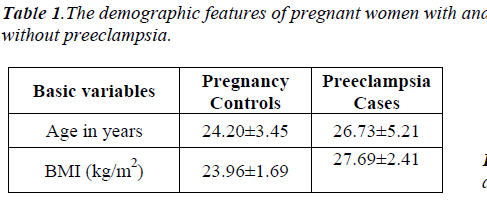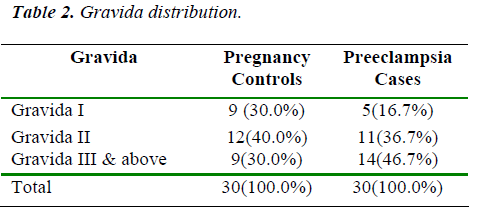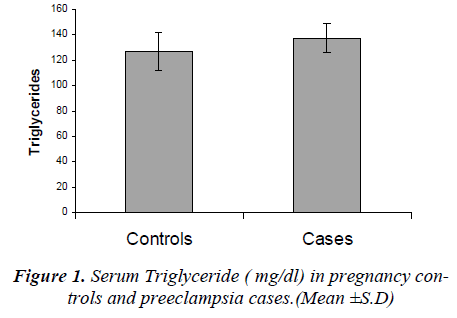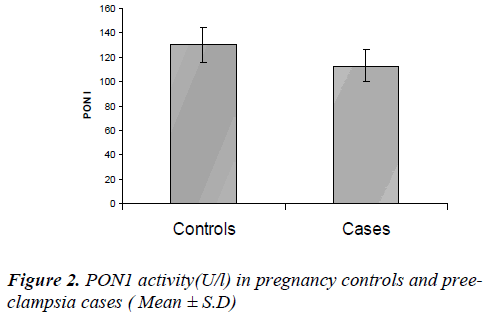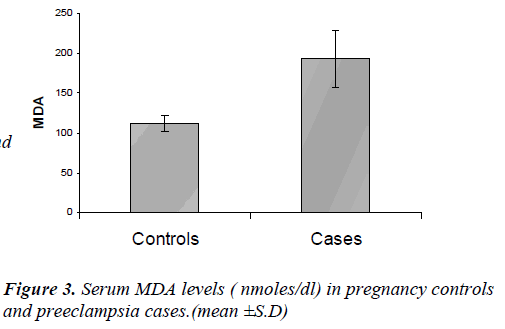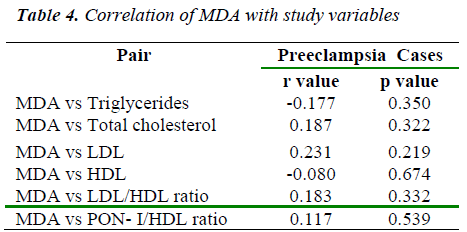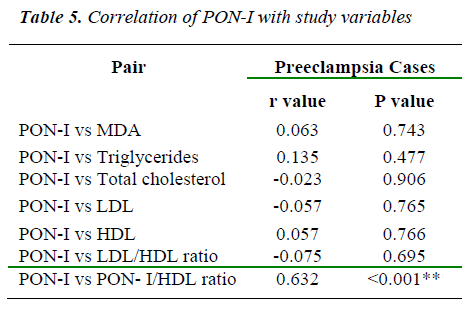- Biomedical Research (2010) Volume 21, Issue 4
Increased level of Lipid peroxidation in preeclamptic pregnancy; a rela-tionship with paraoxanase 1(PON1) activity
KS Meera* , S Maitra, R Hemalatha
Department of Biochemistry, Dr.B.R. Ambedkar Medical College, Shampura Kadugondanahalli, Bangalore, Karnataka, India
- *Corresponding Author:
- KS Meera
Department of Biochemistry
Dr.B.R. Ambedkar Medical College
Shampura Kadugondanahalli
Bangalore,Karnataka
India
E-mail: meera_srinath@yahoo.com
Accepted date: May 07 2010
Abstract
The aim of the study was to evaluate the status and diagnostic utility of PON1as indicator of antioxidant status in preeclampsia. Study groups involved cases, women with preeclampsia (BP >140/90mmHg, edema and proteinuria) (n=30) and controls, pregnant women without preeclampsia or any other complications attending hospital for antenatal checkup (n=30). Both cases and control groups were not on any vitamin E/ vitamin C supplementation. Fast-ing venous samples of blood were collected from both cases and controls. Serum PON1 and serum malondialdehyde (MDA) levels were measured spectrophotometrically. Students in-dependent‘t’ test and Pearsons correlation were used for statistical analysis. We found that PON1 activity in preeclampsia cases were significantly lower than in normal pregnancy con-trols while MDA levels were significantly higher. Conclusion: Our Study showed that the in-crease in Oxidative stress in preeclampsia cases is associated with a decrease in PON1 anti-oxidant activity.
Keywords
Preeclampsia, Paraoxonase
Introduction
Human serum Paraoxonase (PON1) is an enzyme bound to high density lipoprotein (HDL) that hydrolyses oxi-dized phospholipids and inhibits low density lipoprotein (LDL) oxidation. It is the major determinant of antioxi-dant action of HDL.Oxidative stress has been implicated in the pathogenesis of several complication of human pregnancy including preeclampsia. Preeclampsia is a pregnancy specific disorder and its etiopathogenesis is complex and incompletely understood. Preeclampsia is associated with elevated lipid peroxidation and reduced antioxidant status.Preeclampsia is an endothelial disease with a major involvement of lipid mediated oxidative damage.[1] A consistent positive association between maternal dyslipidemia and the risk of preeclampsia have already been found.
MDA is the end product of lipid peroxidation and reflects the oxidative status of the biological system [2]. MDA causes damage to LDL molecules. The altered LDL is taken up by macrophages via scavenger receptors and forms foam cells. [3] This in turn results in atherogenesis.
PON1 (E.C 3.1.1.2) an esterase enzyme associated with HDL exerts a protective effect against oxidative damage of circulating cells and lipoproteins. [4] The hydrolysis of the oxidized phospholipids by PON destroys the biologic- ally active lipids in mildly oxidized LDL. [5] Thereby, HDL and its associated PON1 interrupt a process that would otherwise lead to oxidative damage. PON1 thus can be an indicator of antioxidant status in preeclampsia. Oxidative stress is known to be increased in preeclampsia. Hence this study was aimed to assess the PON 1 activity and MDA levels in preeclampsia along with the Lipid profile and to find their correlation.
Materials and Methods.
The study population consisted of about 60 pregnant women who visited Dr.B.R.Ambedkar Medical College and Hospital, This study was a descriptive study and women with and without preeclampsia was recruited con-secutively. The study protocol was approved by the Insti-tutional Ethics Board.
30 pregnant women with preeclampsia were included in the study. The diagnosis of preeclampsia was based on clinical examination; raised blood pressure (BP>-140/90mmHg), edema and examination of urine for pro-teinuria by dipstick method. 30 normal pregnancies with no preeclampsia or any other complications were included as controls. The exclusion criteria included patients those on vit C/ vit E or antioxidant supplementation or with any other complications other than preeclampsia like gestational diabetes, diabetes mellitus, hypertension, coronary heart disease, impaired renal function, multiple pregnancy and other chronic diseases that might interfere with the study.
Laboratory Assay
Fasting venous blood samples were collected, the sample was centrifuged at 3000rpm for 10 minutes and serum was separated as early as possible and stored for analysis. Paraoxonase activity was determined by measuring the rate of hydrolysis of paraoxon (dimethyl ?p-nitrophenylphosphate) by monitoring the increase of ab-sorbance at 412nm at 37°c. The amount of generated p-nitrophenol was calculated from the molar absorptivity coefficient at a pH of 8.5, which was 18290 mol-1cm-1. [6]PON activity was expressed as U/L serum. One Unit (U) of paraoxanse activity was defined as one micro mol of released p-nitrophenol per litre of serum per minute and expressed in U/L [7]
Serum MDA was estimated using 40% trichloroacetic acid (TCA) and 0.67% thiobarbituric acid (TBA) and ab-sorbance was recorded at 530nm. The MDA content was calculated using the molar extinction coefficient 1.56 x 105 and expressed as nmoles/ dl [8].S total cholesterol, triglyceride and HDL ?C were assayed with BA300 automated chemistry analyzer by using commercially available kits (Diasys diagnostics). The concentration of LDL was calculated using Friedewalds formula.
All statistical analysis was performed using the Statistical Package for the Social Sciences (SPSS) software ver-sion15.0, The comparison of parameters were performed using students ?t? test( two tailed, independent) and corre-lation analysis were performed using Pearsons correlation test.
Results
The demographic features and clinical data of pregnant women with and without preeclampsia are summarized in table 1and 2.The two groups were matched in terms of age and BMI in table 1 and with regards to Gravida in table 2. There was no significant difference in women?s with and without preeclampsia in regards to number of pregnancies.
The total cholesterol (t=3.830; p< 0.001) and triglycerides (t=3.110; p=0,003) were significantly higher in pree-clampsia women as compared to the other group [Figure 1]. The LDL level was significantly higher in women with preeclampsia than in pregnant women without pree-clampsia (t= 3.664; p=0.001). In contrast the HDL level was significantly lower in women with preeclampsia in comparison with pregnant women without preeclampsia (t=2.008; p=0.049). PON1 activity was significantly lower in women with preeclampsia than in pregnant women without preeclampsia (t= 4.906; p< 0.001) where as MDL level and LDL /HDL ratio were significantly higher (t=11.999; p< 0.001, t=3.352; p=0.001 respec-tively). [Figure 2 and Figure 3.] . In addition the PON1 / HDL ratio did not differ significantly between pregnant women with and without preeclampsia [Table 3].
In women with preeclampsia PON-1 activity correlated positively with PON-1/HDL ratio ( r= 0.632,p< 0.001), triglyceride levels ( r=0.135, p= 0.477) and HDL levels (r=0.057;p=0.766) while total cholesterol level ( r=-0.023 ;p=0.906) and LDL levels ( r= -0.057 ;p=0.765) was in-versely correlated ( Table 3). The MDA levels were posi-tively correlated in preeclampsia women with total cho-lesterol (r= 0.187; p=0.322), LDL (r= 0.231; p=0.219), LDL/HDL ratio (r=0.183; p= 0.332) and PON-1 / HDL ratio (r=0.117; p=0.539). In addition there was inverse correlation between MDA and triglyceride level (r= - 0.177; p= 0.350) and HDL levels (r= -0.080; p=0.674) [Table 4].
PON-1 Activity also correlated positively with MDA levels in preeclampsia women (r= 0.063; p=0.743) though not statistically significant [Table 3].
Discussion
There are several proposed mechanisms for explaining the anti atherogeneic properties of HDL. PON1 is calcium dependent esterase, is exclusively bound to the HDL frac-tion of serum. [9]. PON1 prevents the oxidative modifica-tion of LDL and is responsible for the antioxidant activity of HDL [2]. Preeclampsia has been associated with atherogenic wall changes in the uteroplacental bed.[10] These changes consequently results in necrosis of vessel wall and accumulation of lipid laden foam cells with oxi-dized LDL.In preeclampsia, the placental damage is pro-gressive and can be compensated for sometime depending on the severity of initial placental defect and intrinsic pla-cental antioxidant capacity.[11]
Lipid peroxides are directly involved in mediating mater-nal endothelial dysfunction by increasing the production of thromboxane A2 and the expression of cell adhesion molecules in the uteroplacental vasculature as well as in the maternal peripheral vasculature.[12] Maternal plasma lipids are significantly elevated during pregnancy. In preeclampsia dyslipidemia pattern of increased concentration of triglyceride, cholesterol and LDL and decreased concentration of HDL have been noticed. Peroxidation of lipids brings about changes in its molecular structure and these changes becomes more marked when the damaged lipids are the constituents of biological membrane Low antioxidant levels may aggravate prooxidant injury on endothelial cells, altering prostacyclin ? thromboxane balance and culminating in preeclampsia.[13],[14]. Hence mechanisms that prevent oxidation of LDL have received increased attention in recent years. One such mechanism is prevention of LDL oxidation by PON1.
In the current study it was found that the PON1 activities were significantly lower in women with preeclampsia than in women with normal pregnancy. MDA levels were significantly higher in preeclampsia cases. The increased MDA levels in preeclampsia is known to be due to in-creased generation of reactive oxygen species and in-creased oxygen demand along with reduction in activities of enzymes like superoxide dismutase, glutathione per-oxidase and decrease in concentration of antioxidants like Vitamin C and Vitamin E.Reactive oxygen species can cause enhanced lipid peroxidation.
Uzun, Benian, Madazh, Topcuoglu, Aydin, Albayrak [15] have reported oxidative stress and decreased paraoxonase activity in preeclampsia. Decreased PON1 activity can cause damage to the vascular endothelium. Preeclampsia results in an increased vascular oxidative stress and endo-thelial damage; although it is not very clear whether this phenomenon occurs before or after the development of preeclampsia. PON1 modulates the susceptibility of HDL to atherogenic modifications such as oxidation, glycation and homocysteinylation and even exerts an anti-inflammatory role.
In Summary, this study has found increased MDA levels and decreased PON1 activity in preeclampsia. The de-crease in PON1 activity is associated with decreased HDL levels. It is not very clear whether PON1 activity reduct-ion is a consequence of decreased HDL levels or increas-ed oxidative stress. Further studies are required to substa-ntiate the postulated correlation between the lower para-oxonase activity level and pathophysiology of preeclamp-sia.
References
- Ray JG, Diamond P, Singh G, Bell CM. Brief overview of maternal triglycerides as a risk factor for pre-eclampsia .BJOG.2006;113: 379-386.
- Dursen P, Demirtas E,Bayrak A, Haken Yarli. De-creased serum paraoxonase 1 (PON1) activity: an addi-tional risk factor for atherosclerotic heart disease in pa-tients with PCOS. Human Reproduction 2006; 21(1): 104-108.
- Nadiger HA, Mathew CA, Sadasivudu B. Serum malondialdehyde (TBA reactive substance) levels in cigarette smokers. Atherosclerosis 1987; 64 : 71-73.
- Ferretti G, Bacchetti T, Moroni C, Savino S, Liuzzi A, Balzola F et al. Paraoxonase activity in high-density lipoprotein; A comparison between healthy and obese females. J Clin Endocrinol Metab 2005; 90: 1728-1733.
- Sutherland WHF, Walker RJ, dejong SA, Van Rij AM, Phillips V, Walker HL. Reduced postprandial serum paraoxonase activity after a meal rich in used cooking fat. Arterioscler Thromb Vasc Biol 1999; 19: 1340 -1347.
- Eckerson HW, Wyte MC, La Du Bu. The human serum paraxonase arylesterase polymorphisim. Am J Hum Genet. 1983; 35: 1126-1138.
- Krzystek ?Korpacka M, Boehm D, Matusiewicz M, Diakowskar D, Grabowski K, Gamian A. Paraoxanase 1 (PON1) status in gastroesoohageal malignancies and as-sociated paraneoplastic syndoromes- Connection with inflammation. Clin Biochem. 2008; 41: 804 -811.
- Antani J, Sadasivudu.B, Singh PS, Rao SH, Reddy K.L. Serum nitrite and malondialdehyde in hypertension and myocardial ischaemia. Med Sic Res 1996; 24: 671-674...
- Koppasch S. Pietzsch J, Kuhlisch E, Craessler J. Lack of association between serum paraoxonase activities and in-creased oxidized low density lipoprotein levels in impaired glucose tolerance and newly diagnosed diabetes mellitus. J Clinc Endocrinol Metabolism 2003: 88: 1711-1716
- Gratacose E, Lipid mediated endothelial dysfunction: a common factor to preeclampsia and chronic vascular disease. Eur J Obstec Gynecol Reprod Biol 2000: 92: 63-66.
- Burton GJ, Jauniaux E. Placental oxidative stress: From miscarriage to preeclampsia. J Soc Gynecol Investig 2004; 11: 342-352.
- Wang Y, Walsh SW. Increased superoxide generation is associated with decreased superoxide dismutase activity and mRNA expression in placental trophoblast cells in preeclampsia. Placenta 2001; 22: 206-212.
- Wang YP, Walsh SW, Guo JD. Maternal levels of prostacyclin, thromboxane, Vitamin E and lipid perox-ides throughout normal pregnancy. Am J Obstet Gyne-col. 1991; 165: 1690-1694.
- Hubel CA, Roberts JM, Taylor RN, Musci TJ, Rogers GM, McLaughlin MK. Lipid peroxidation in pregnancy: New perspectives on preeclampsia. Am J Obstet Gyne-col 1989; 161: 1025-1034.
- Uzun H, Benian A, Madazh R, Topcuoglu MA, Aydin S, Albayrak M. Circulating oxidized low - density lipo-protein and paraoxanase activity preeclampsia . Gynecol Obstet Invest 2005; 60: 195-200.
